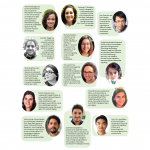Meike Hüdig: The Plant Cell First Author

 Meike Hüdig, co-first author of “Respiratory and C4-photosynthetic NAD-malic enzyme coexist in bundle sheath cell mitochondria and evolved via association of differentially adapted subunits”
Meike Hüdig, co-first author of “Respiratory and C4-photosynthetic NAD-malic enzyme coexist in bundle sheath cell mitochondria and evolved via association of differentially adapted subunits”
Current Position: Postdoc at the Plant Molecular Physiology Division, University of Bonn, Germany.
Education: PhD in Biology at Heinrich Heine University, Düsseldorf, Germany; MSc in Biology and BSc in Biology at University of Münster, Germany.
Non-scientific Interests: Molecular cooking and general foodie, hiking, geocaching.
Brief bio: I started my plant science career as a Bachelor student looking for regulatory protein isoforms in rice peroxisomes in the von Schaewen lab and found my love for calcium signaling in the chloroplast as a Master student in the Kudla lab, both inspiring me to dive deep into confocal microscopy at the University of Münster. Sitting hours and hours in a dark cold room at my beloved microscope continued in multiple projects during my PhD with Prof. Maurino at the University of Düsseldorf, allowing me to work on diatom, tobacco and Arabidopsis proteins unraveling subcellular location, interaction and enzymatic properties.
Working on the overall evolution of enzymes and understanding their molecular changes is at the heart of my postdoc work at the University of Bonn. Here I focus on understanding C4 photosynthesis evolution. I use maize and Cleome species to understand what needed to change on a molecular level to make the plants perform the improved version of photosynthesis. So that we can teach our crops like rice, wheat or barley to be able to grow in hotter, drier climate and grow bigger to contribute to food and feed safety.
姓名:軤丁 麦克
职位:德国波恩大学植物分子生理学系博士后
学历:博士
兴趣爱好:烹饪,徒步旅行,寻宝
个人简介:我成为一名本科生后开始了我的植物科学研究生涯,在 von Schaewen 实验室寻找水稻过氧化物酶体中的调节性 蛋白质 异构体,之后成为硕士生在 Kudla 实验室发现了我对叶绿体中钙信号的热爱,这两者都激励我在明斯特大学深入研究共聚焦显微镜。在杜塞尔多夫大学Maurino教授实验室攻读博士学位期间,我经常呆在黑暗且寒冷的实验环境中持续几个小时的使用显微镜进行多个项目的研究,这使得我能够进行硅藻、烟草和拟南芥蛋白质的研究。
研究酶的整体进化并了解它们的分子变化是我在波恩大学博士后工作的核心。在这里我重点研究 C4 植物光合作用的进化。 我使用玉米和 醉蝶花来研究需要在分子水平上进行哪些改变才能使植物实现改进的光合作用。 这样我们就可以指导其他作物,如水稻、小麦或大麦,使其能够在干燥炎热的气候中生长,并长得更大,从而为食品和饲料安全做出贡献。



